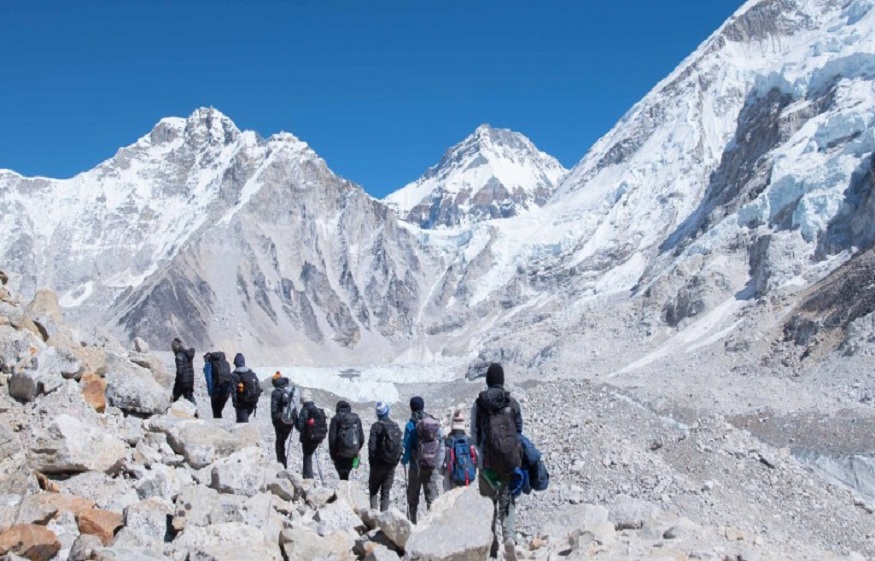
Altitude Chart for Everest Base Camp Trek: Know the Highs & Lows
Mount Everest is one of the most magnificent mountains in the world, and the Everest Base Camp Trek is probably one of the most popular trekking routes on the planet, so it’s no wonder that four of them visit Everest every year. But many trekkers find the altitude of the excursion somewhat difficult. The altitude differences a trekker can experience on the trail can vary widely, with elevations ranging from 2,860 meters (9,383 feet) at Lukla to 5,364 meters (17,598 feet) at Everest Base Camp. Understanding the altitude chart for the trek properly can thus set our expectations right and help plan for a successful and enjoyable trek that includes adequate acclimatization.
Trek To Base Camp Mount Everest The journey starts at Lukla, which is at roughly 2,860 meters (9,383 feet). This is where most trekkers start their journey upon landing in Lukla via a small plane. From here, hikers will descend slightly to Phakding and continue on the trail, which gradually rises through the lush Sagarmatha National Park. The journey combines a gradual upward route through traditional Sherpa villages, comprising Namche Bazaar, Tengboche, Dingboche, and finally Everest Base Camp.
And one of the main factors in the success of the trek is the rate of elevation gain. The trekking trail is made in such a way that it gradually increases the altitude so that the human body gets used to the decreasing oxygen level. For instance, the day after leaving Namche Bazaar, trekkers take a rest day to acclimatize, a necessity to stave off altitude sickness. This is an important stop on the journey because altitude sickness can impact anyone, regardless of how fit they are.
The first major stop along the trail, Phakding, is another few hours’ hike away, at 2,610 meters (8,563 feet). From Phakding, it’s on to Namche Bazaar — a busy Sherpa town that sits at 3,440 meters (11,286 feet). Namche is the first major acclimatization stop, and trekkers usually overnight here at least for a day of resting and acclimatizing.
The trail continues up to Tengboche at 3,860 meters (12,664 feet), where trekkers can enjoy breathtaking views of Mount Everest and Ama Dablam. From here, the trek continues on to Dingboche at 4,410 meters (14,468 feet). The impact of high altitude is more pronounced at this point, and trekkers frequently want an additional acclimatization day.
From Dingboche, hikers make the climb toward Lobuche at 4,940 meters (16,210 feet) and then the final push to Everest Base Camp, at 5,364 meters (17,598 feet). This is the first close view of Mount Everest for the trekkers, a big reward for their hard work and determination.
And though altitude is the biggest struggle, the trek rewards you with beautiful views of the Himalayas, with notable summits like Lhotse, Nuptse, and Makalu in sight, making all the efforts feel worth it. With rich Sherpa culture, ancient Buddhist monasteries, and stunning views, the Everest Base Camp Trek is a soul-filling experience.
It is worth noting that oxygen content also decreases as trekkers ascend, leaving physical effort more challenging. At elevations above Lobuche and Everest Base Camp, trekkers frequently suffer from fatigue, shortness of breath, and loss of appetite. These symptoms are not unusual at high altitudes, but can be managed with proper acclimatization, hydration , and rest.
Everest Base Camp Trek For those attempting to complete the trek, reading the altitude chart is an important first step to plan resting days and allow a slow climb to get used to the altitude. Being aware of altitude-related symptoms, like headaches or nausea, and knowing when to seek help can help ensure that trekkers enjoy the journey without jeopardizing their health. While this post is a great guide to get prepared for the wonderful adventure ahead, it is important to note that to should always consult with a healthcare professional before you start your journey, and that a fully prepared trekker is more likely to achieve their goal of making it to the coveted Everest Base Camp.
Altitude on the Everest Base Camp Trek
While the Everest Base Camp Trek is famous for stunning views of the Earth’s tallest mountain, the trek is also known for its high altitudes. Beginning about 2,860 meters (9,383 feet) in Lukla, trekkers slowly climb toward Everest Base Camp at 5,364 meters (17,598 feet). Once you start going up, you need to adapt properly to avoid altitude sickness. Altitude can play a huge role in your trek experience, so any trekker considering this journey must understand the effects, too. You walk through villages and valleys, gaining altitude with each step. Like many high-altitude treks, altitude sickness is a real concern and occurs when the body struggles to acclimatise to lower oxygen levels up in the skies. That’s why it’s so important to go slow, give your body time to adjust to the demands being placed on it, and take rest days to avoid complications. Understanding the specific elevations and their effects on the body is crucial for organizing a safe and pleasant hike. To help you on this memorable journey, knowing the impacts of altitude, tactics for acclimatization to higher elevations, and these landmarks will help ensure you make it safely and successfully to Everest Base Camp.
What Happens to the Body at High Elevation
As you climb up to higher elevations on the Everest Base Camp Trek, the air pressure and oxygen level begin to decline. That means your body has to work harder to transport oxygen to your muscles and organs. Above an altitude of 2,500 meters (8,200 feet), the concentration of oxygen in the air begins to drop significantly enough to cause altitude sickness. Typical symptoms include headaches, nausea, dizziness, breathlessness and fatigue. This lower level of oxygen requires a period in which the body adjusts, called acclimatization. If you go up too fast and do not give your body enough time to rest, the body is unable to adapt, with the result that you may develop acute mountain sickness (AMS). To help prevent AMS, trekkers should adhere to the general guideline of ascending no more than 500 meters (1,640 feet) in elevation daily after surpassing 3,000 meters (9,843 feet). Symptoms can worsen with rapid ascents, and at higher altitudes (above 4,500 meters / 14,764 feet), the risk of more serious conditions such as high-altitude pulmonary edema (HAPE) or high-altitude cerebral edema (HACE) also increases. By allowing for more gradual ascents on routes and including acclimatization down days at strategic points along the trek, trekkers can dramatically decrease the chances of altitude-linked health problems. You just need to listen to your body, drink enough water, be aware of early signs of AMS, and take preventative measures before any grave conditions set in.
High Altitude Overview of Everest Base Camp Trek
Everest Base Camp Treks is a unique chance to witness the majestic beauty of the Himalayas, with towering Mount Everest as the centerpiece. But hiking at such high altitudes does have some caveats, and you need to pay attention to changes in elevation. The trek starts in Lukla, at 2,860 meters (9,383 feet), just high enough to feel the altitude but still far from any serious altitude-related problems. The trail then travels through a series of lovely Sherpa hamlets, including Phakding and Namche Bazaar, before continuing higher to Tengboche, Dingboche, and Lobuche. All of the towns sit at increasingly higher altitudes, allowing trekkers to set a slow pace that allows their bodies to acclimatize to the reduced oxygen levels. The endpoint is Everest Base Camp, set at an elevation of 5,364 meters (17,598 feet). As tikers move, the oxygen levels rapidly deplete, and the climb to base camp becomes a challenge. Trekkers should plan rest days and gradual ascension to higher elevations to account for the risk of altitude sickness. Altitude is one of the most important considerations for your trek success. Learning how to ward off such challenges takes time, mindfulness, and acclimatization strategies, all of which are the true keys to having a safe, enjoyable trek full of life-changing views and destinations at one of the world’s most iconic locations.
Important Ascents Oct 2023 on the Trek
After all, the Mount Everest base camp Trek is a slow ascent through some of the most beautiful scenery on earth. Thus, understanding the Key Elevation Points on the Trek is highly significant to analyze your body reaction towards increasing altitude. From the starting point at Lukla (2,860 meters / 9,383 feet), the trek goes through many higher-altitude villages. Your first major stop is Phakding at 2,610 meters (8,563 feet). (While this is a slight drop in altitude from Lukla, the thinning air will begin to take its toll on trekkers as they ascend.) Above Phakding, trekkers arrive in Namche Bazaar, located at 3,440 meters (11,286 feet), a lively town and a crucial stopover for acclimatization. From Namche, trekkers climb to Tengboche, at 3,860 meters (12,664 feet), which is where trekkers often stop to enjoy sweeping views of the Himalayan peaks. The next main stop is Dingboche at 4,410 meters (14,468 feet), followed by Lobuche at 4,940 meters (16,210 feet). Finally, the trek culminates in a stunning view of the iconic Everest Base Camp, which stands at a height of 5,364 metres (17,598 feet). These are considered the major hiking tips to keep in mind, and each of these vital elevation points helps in acclimatizing the trekkers to the high-altitude conditions, enabling them to have a safe and breathtaking trek.
Lukla (2,860 m / 9348 ft)
The trek to Everest base camp starts in Lukla, a small town in the Khumbu region of Nepal located at 2,860 meters (9,383 feet) above sea level. Most trekkers arrive in Lukla by small plane a small native airfield that approaches through high mountain passes, making it a thrilling entrance way for many trekkers. Although it has a low altitude, Lukla is the place where you start your trek, and the quick ascent from Kathmandu, at just 1,400 meters (4,593 feet), can already have some trekkers feeling the effects. Lukla is a necessary stop for trekkers, with important services available such as hotels, shops, and trekking gear stores. Although the altitude here generally isn’t high enough to cause severe altitude problems, trekkers can benefit from taking it easy and resting after the flight to give their bodies time to adapt to the lower level of oxygen in the air. The trek from Lukla follows the Dudh Kosi River valley and gradually gains altitude. Altitude sickness is real and should not be taken lightly, so Lukla is an ideal springboard for the trek into the heart of the Himalayas, and the support it provides comes with many amenities.
Today: Phakding (2,610 meters / 8,563 feet)
Everest Base Camp Perched at 2,610 meters (8,563 feet), Phakding is the first village that most trekkers come across after leaving Lukla. The trek to Everest base camp and then into the village is relatively low in altitude compared to other points on the trek to Everest base camp, making Dingboche the perfect place to get started in your acclimatization process. The trek to Phakding is relatively gentle, with a gradual uphill as we follow the path of the Dudh Kosi River. But while Phakding is at a pleasant altitude, it’s still important for the trekkers to be alert to what their bodies are telling them about the higher altitude. In the refreshing and tranquil environment of Phakding — worlds apart from the chaos of Lukla — trekkers can rest and replenish. Phakding Keep an eye out for early symptoms of altitude sickness, like headaches or dizziness. If any symptoms of altitude-related problems develop, trekkers can consult their guides or take extra rest days. From there, journeying on to Namche Bazaar?
Namche Bazaar (3,440mt / 11,286ft)
Namche Bazaar at an altitude of 3,440 meters (11,286 feet) is the first major village trekkers pass on leaving Lukla. It also acts as an important acclimatization stop because it is one of the higher points you’ll reach on the trek to Everest Base Camp. Namche is, famously, the gateway to the Everest region, a colorful Sherpa town with an animated culture and heavily electrified atmosphere. Although it’s a nice place to lie down and get restored, it’s also a good place for trekkers to start acclimatizing to the effects of higher altitudes. Symptoms of altitude sickness can begin at Namche, so acclimatization is an important part of the trek. Many trekkers stop here for a day or two to acclimatize before pushing on to higher elevations. There are also a number of treks to do around Namche, including the day trip to Everest View Hotel, which offers great views over Mount Everest, Ama Dablam, and the surrounding peaks. In Namche, you will find lodges, cafes, and shops, so it is a more comfortable and convenient stop for trekkers. Stunning viewpoints, unavoidable culture, and the first supplies for acclimatization, Namche Bazaar is one of the highlights of the trek.
Tengboche (3,870 m / 12,697 ft)
Himalayan Base Camp Trek 3,870 meters (12,697 feet), Tengboche is a beautiful village of great spiritual importance. One of the most sacred Buddhist monasteries around the region, the Tengboche Monastery is set on the hillside overlooking the Imja Khola River. Namche Bazaar and Tengboche. The trek from Namche Bazaar to Tengboche is beautiful with views of Mount Everest, Lhotse, and Ama Dablam, a favorite stop point for photographers. Tengboche is a great place to adjust to altitude, and one of the town’s most well-known landmarks is its world-famous monastery. It’s important to monitor all early symptoms of altitude sickness. Trekkers often sleep at Tengboche, both to enjoy the monastery and the nearby scenery and to acclimatize in preparation for the higher elevation trek to Dingboche or Pheriche. However, the unearthly beauty and timeless tranquillity of the place, complemented with the sanctity of the monastery, make Tengboche one of the most memorable stops on the Everest Base Camp Trek.
Dingboche (4410 meters / 14469 feet)
Dingboche, at 4,410 meters (14,469 feet), is an important acclimatization stop for trekkers proceeding to Everest Base Camp. Dingboche, in the Imja Valley, is a quiet village with fields of stone-walled terraces and views of peaks such as Ama Dablam and Lhotse. By the time trekkers arrive at Dingboche, they are well over 4,000 meters (13,123 feet) elevation, and so acclimatization becomes even more crucial. To assist with this, trekkers usually linger an extra day at Dingboche, hiking up to more vertical elevation (such as to Nangkartshang Peak) to acclimatize their bodies. At Dingboche, the oxygen levels are lower than those felt in Namche Bazaar and can cause mild breathlessness if you’re physical activity. Dingboche is an ideal place to acclimatize before attempting the higher areas of Lobuche and Gorak Shep. There are lodges, tea houses, and small shops in the village, which serve as a comfortable stopover for trekkers. The views around, particularly of Ama Dablam, are impressive, which allows Dingboche to be an important part of the Everest Base Camp Trek.
Lobuche (4,910 m / 16,109 ft)
Everest Base camps Perched at 4,910 meters (16,109 feet), Lobuche is a tiny settlement that is the last major stopping point before you reach Gorak Shep, and, eventually, Everest Base Camp. One of the more physically difficult sectors, due to the increase in altitude and greater rock terrain, is the trek from Dingboche to Lobuche. Most trekkers stop at Lobuche to rest before making the final push to Gorak Shep and Everest Base Camp. Because of the high elevation, the air here has much lower oxygen levels than at lower elevations, and trekkers often begin to experience the effects of altitude, like shortness of breath and fatigue. Lobuche is one of the critical points to keep track of how your own body is responding, you may need to rest if it’s necessary. The surrounding views, however, are breathtaking, showcasing a panoramic landscape of jagged Himalayan peaks, including the Nuptse, Pumori , and Lhotse. It is a sparse, quiet community with basic lodgings and tea houses, a place where trekkers can stay to get prepared for climbing the little hill to Everest Base Camp. The anticipation builds as the end of the trek is in sight, and the altitude can be tough.
Gorak Shep (5,140m / 16,864ft)
DESTINATION: Gorak Shep, 5,140 m (16,864 ft) — the final stop before entering Everest Base Camp. Lobuche to Gorak Shep: This trek section is tiring and difficult as you will be in thinner air, and the terrain is rocky and harsh. One accommodation option at this location is Gorak Shep, a tiny settlement that offers only basic facilities, such as rudimentary lodges and tea houses. To acclimatize and prepare for the last checkpoint before heading to Everest Base Camp, the actual place. It is common for trekkers at this altitude to suffer from symptoms of altitude sickness — headaches, nausea, shortness of breath, and other effects. It’s important to be careful, drink plenty of water, and pay attention to your body. After departing from Gorak Shep, it’s just a few hours to reach Everest Base Camp, where the thrill of standing at the foot of the world’s highest mountain kicks in. Gorak Shep is the last stop before the summit of the trek, and the views of Mount Everest, along with the sense of accomplishment, are astounding.
Everest Base Camp (5,364 m / 17,598 ft)
By the end of the Everest Base Camp trek cost, you will find yourself at Everest Base Camp at an altitude of 5,364 meters (17,598 feet). The hike to Base Camp is strenuous, given the altitude, but most people agree that the reward is well worth the effort. A journey to Base Camp gives trekkers a taste of Everest’s unmatched beauty, watch in awe as they pass the Khumbu Icefall and get a close-up glimpse at Mount Everest living much, much closer than the apex of the world. The trek to Everest Base Camp is taxing both physically and mentally, especially since trekkers will have spent days acclimatizing to the thinning air. Trekkers around this elevation may experience fatigue, breathlessness, and light-headedness, which makes acclimatization very important. Notwithstanding the challenges, the sense of satisfaction upon arriving at Everest Base Camp is unparalleled. Trekkers snap photos, savor the views, and contemplate the epic journey they’ve just completed. Constitutional plateau standing at the bottom of the highest bonds is a memory that will last a lifetime, and the surrounding camp is a rock with a towering rock wall, a unique experience.Reach out any time with your travel queries at info@sherpaexpeditiontrekking.com or send a quick WhatsApp message to +977 9866007038 — we’re happy to help!






